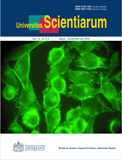Abstract
Objetivo: Demostrar la presencia de Rotavirus en las diferentes fases de un proceso de compostaje: matrices utilizadas como materia prima, mezcla a compostar y producto terminado. Materiales y métodos. El Rotavirus se determinó durante los tres procesos de compostaje. La detección viral se realizó por inmunocromatografía, ELISA y RT- PCR. Resultados. Se evidenció presencia viral en el primer proceso de compostaje, ausencia viral en el segundo y en el tercer proceso de compostaje, se presentaron interferencias que dificultaron interpretar los resultados de la PCR, lo cual impidió llegar a un resultado concluyente de su presencia en el abono. Conclusiones. Los abonos orgánicos pueden ser portadores de virus motivo por el cual se deben implementar pruebas de calidad para evitar que este material contribuya con la diseminación viral. Dentro de estos abonos existen sustancias capaces de interferir en las pruebas de detección
Palabras clave: Abonos, compostaje, inhibidores de la PCR, Rotavirus
Abstract
Rotavirus presence in a waste composting process. Organic fertilizers as vehicles for viral contamination. Objective. To show the presence of rotavirus in different stages of a composting process: matrices used as raw material, mixture to be composted and the final product. Materials and methods. Immunochromatography, ELISA and RT-PCR were used for viral detection. Results. Rotavirus was found in the first composting step, no virus was found in the second step, and some inhibitory substances were found in the third step that posed difficulties in interpreting the PCR results and therefore providing a concluding result on rotavirus presence in the final product. Conclusions. Organic fertilizers can be vectors of human pathogenic viruses; therefore quality control tests must be implemented to avoid further viral dissemination. There are inhibitory substances present in organic fertilizers capable of interfering with the detection tests.
Key words: composting, organic fertilizers, PCR inhibitors, rotavirus
Resumo
Presença de rotavírus durante um processo de compostagem. Adubos como vetores de contaminação viral. Objetivo.Demonstrar a presença de Rotavírus nas diferentes fases de um processo de compostagem: matrizes utilizadas como matéria-prima, mistura de composto e produto final. Materiais e métodos: A determinação do Rotavírus foi realizada nos três processos de compostagem. A detecção viral foi realizada por imunocromatografia, ELISA e RT-PCR. Resultados. Evidenciou-se a presença viral no primeiro processo de compostagem, ausência de vírus no segundo, e no terceiro processo de compostagem, apresentaram-se interferências que dificultaram a interpretação dos resultados da PCR, tornando impossível chegar a um resultado conclusivo de sua presença no adubo. Conclusões. Os adubos orgânicos podem abrigar o vírus é por isso que se devem implementar provas de qualidade para evitar que esse material contribuía com a disseminação viral. Dentro desses fertilizantes existem substâncias capazes de interferir nas provas de detecção.
Palavras-chave: fertilizantes, compostagem, os inibidores da PCR, rotavírus
Univ. Sci. is registered under a Creative Commons Attribution 4.0 International Public License. Thus, this work may be reproduced, distributed, and publicly shared in digital format, as long as the names of the authors and Pontificia Universidad Javeriana are acknowledged. Others are allowed to quote, adapt, transform, auto-archive, republish, and create based on this material, for any purpose (even commercial ones), provided the authorship is duly acknowledged, a link to the original work is provided, and it is specified if changes have been made. Pontificia Universidad Javeriana does not hold the rights of published works and the authors are solely responsible for the contents of their works; they keep the moral, intellectual, privacy, and publicity rights. Approving the intervention of the work (review, copy-editing, translation, layout) and the following outreach, are granted through an use license and not through an assignment of rights. This means the journal and Pontificia Universidad Javeriana cannot be held responsible for any ethical malpractice by the authors. As a consequence of the protection granted by the use license, the journal is not required to publish recantations or modify information already published, unless the errata stems from the editorial management process. Publishing contents in this journal does not generate royalties for contributors.



